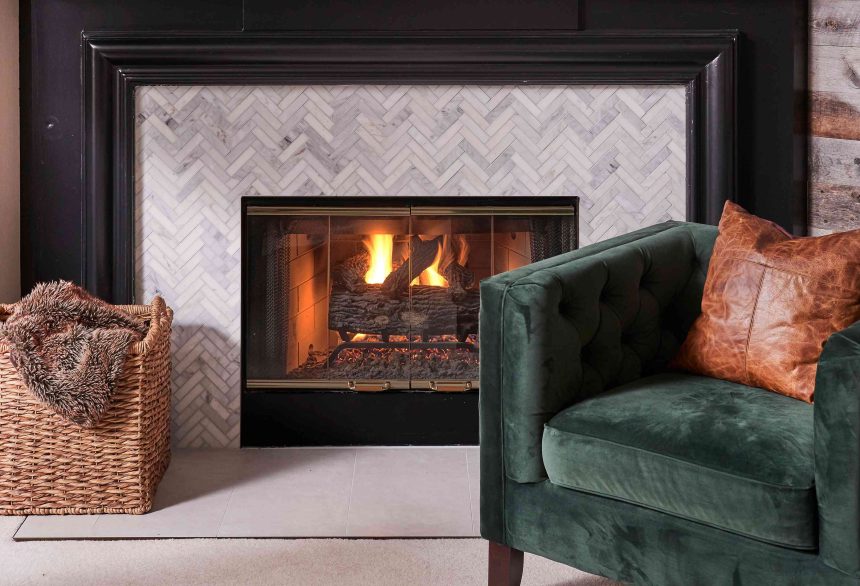A gas fireplace is a coveted amenity that provides warmth and unbeatable ambiance to any living space. Since the fireplace is fueled by gas instead of wood, you don’t even need to worry about fetching logs to keep the fire going well into the evening. The one major consideration of a gas fireplace is that it will only function properly if the pilot light is on. So, before attempting to start a fire, it’s important to check the fireplace pilot light.
Ideally, the pilot light will burn with a steady, blue flame, indicating that it’s safe to start the fire, but if you notice the flame is burning yellow, flickering, or has been extinguished completely, then you will need to take action before you’ll be able to light the fire. Use this guide to learn everything you need to know about fireplace pilot lights.
What Is a Fireplace Pilot Light?
If you have a gas furnace heating your home, then you may already have a good understanding of what a pilot light is and how it functions. A fireplace pilot light is no different. However, if you have an electric furnace or you leave your HVAC maintenance to a professional, you might not know that a fireplace pilot light is a small, continuously burning flame that is intended to ignite the main gas burner when you turn on the fireplace.
The fireplace pilot light acts as a ready ignition source, so you don’t need to worry about trying to ignite the gas with a barbecue lighter or a similar igniter. Additionally, gas fireplaces will have a component known as a thermocouple, which is designed to prevent gas leaks by automatically closing the gas valve if the pilot light goes out. However, if you have a faulty thermocouple, the gas might continue to flow into the home, potentially creating a hazardous situation—so it’s important to regularly check and maintain the fireplace and fireplace pilot light.
How Does a Fireplace Pilot Light Work?
A fireplace pilot light functions like a readily available source of ignition for the fireplace, so all you need to do is turn the fireplace on to light the fire. A pilot light is comprised of a thermocouple, gas valve, electric ignition source, and a small pilot tube that carries the gas to the pilot light.
Essentially, a small amount of gas flows through the pilot tube to the pilot light where it is ignited by the electric ignition source. When the fireplace is turned on, gas flows to the main burner, which is ignited by the pilot light. This is what produces a larger flame in the fireplace. Even when the fireplace is off, the pilot light will remain lit. The thermocouple sensor detects the heat from the pilot light and sends a signal to keep the gas valve open, but if the pilot light is extinguished, then the thermocouple will send a signal to the gas valve to stop the flow of gas to the pilot light.
When (and How) to Relight a Fireplace Pilot Light
Typically, the fireplace pilot light will remain lit—but there are some circumstances in which the pilot light may go out. This can happen if there is a strong draft in the home, or a gust of wind through an open door or window. It may also happen during a power outage, since fireplace pilot lights generally have an automatic electric igniter that would otherwise relight the pilot light.
Some homeowners will also turn off the pilot light during the summer months when the fireplace is not in use, so you would need to relight the pilot light in the fall. Similarly, if the fireplace pilot light is on a timer, then it might automatically turn off after several days if the fireplace is not used. You should refer to the owner’s manual to determine the exact method for relighting the fireplace pilot light, but in most cases this can be accomplished by turning the control knob to the “pilot” position, then pressing and holding the ignition button until the flame is established.
Alternatively, if the fireplace does not have an automatic electric igniter, then you might need to relight the pilot light using a barbecue lighter or a long match. Simply push down on the ignition button to allow gas to flow to the pilot light, before lighting the pilot light with the lighter or lit match, then release the ignition button.
Other Fireplace Pilot Light Considerations
Beyond checking if the fireplace pilot light is lit and reigniting it if the flame has gone out, there are a few additional factors to keep in mind.
- Inspect the fireplace and fireplace pilot light regularly for signs of soot buildup, vent obstruction, flame quality, and the overall cleanliness of the pilot tube.
- Test to make sure the thermocouple and gas valve are operating properly by extinguishing the pilot light flame and checking to ensure the flow of gas is stopped.
- Some areas require the fireplace pilot light to have a seven day timer to improve energy conservation and reduce environmental impact. If the fireplace is used within the seven day period, then the timer will reset, but if the fireplace is not used within seven days, then the pilot light will be extinguished.
- Typically, you can simply turn the fireplace on and the electronic ignition will relight the pilot light automatically, though in some cases you may need to manually relight the pilot light.
- Regularly clean the fireplace and fireplace pilot light assembly to keep the fireplace functioning as intended. Make repairs as soon as possible to prevent problems with the fireplace.
- If you notice that the thermocouple or gas valve are not working properly, turn off the gas to the fireplace until the problem can be fixed by a professional. This will reduce the risk of carbon monoxide poisoning and help prevent fire hazards.







